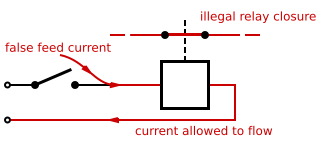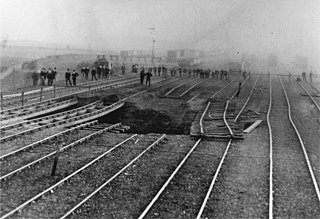
Double switching, double cutting, or double breaking is the practice of using a multipole switch to close or open both the positive and negative sides of a DC electrical circuit, or both the hot and neutral sides of an AC circuit. This technique is used to prevent shock hazard in electric devices connected with unpolarised AC power plugs and sockets. Double switching is a crucial safety engineering practice in railway signalling, wherein it is used to ensure that a single false feed of current to a relay is unlikely to cause a wrong-side failure. It is an example of using redundancy to increase safety and reduce the likelihood of failure, analogous to double insulation. Double switching increases the cost and complexity of systems in which it is employed, for example by extra relay contacts and extra relays, so the technique is applied selectively where it can provide a cost-effective safety improvement.
The Norton Fitzwarren rail crash occurred on 4 November 1940 between Taunton and Norton Fitzwarren in the English county of Somerset, when the driver of a train misunderstood the signalling and track layout, causing him to drive the train through a set of points and off the rails at approximately 40 miles per hour (64 km/h). 27 people were killed. The locomotive involved was GWR King Class GWR 6028 King Class King George VI which was subsequently repaired and returned to service. A previous significant accident occurred here on 10 November 1890 and the Taunton train fire of 1978 was also within 2 metres.

Zanthus is a remote and uninhabited outpost on the Trans-Australian Railway approximately 210 kilometres (130 mi) east of the regional city of Kalgoorlie in the Goldfields–Esperance region of Western Australia.

The Harrow and Wealdstone rail crash was a three-train collision at Harrow and Wealdstone station in Wealdstone, Middlesex during the morning rush hour of 8 October 1952. The crash resulted in 112 deaths and 340 injuries, 88 of these being detained in hospital. It remains the worst peacetime rail crash in British history and the second deadliest overall after the Quintinshill rail disaster of 1915.
The Valigonda rail disaster occurred on 29 October 2005 near the town of Valigonda, south of Hyderabad in the Indian state of Telangana. A flash flood swept away a small rail bridge, and a "Delta Fast Passenger" train traveling on it derailed at the broken section of the line, killing at least 114 people and injuring over 200.
The Bourne End rail crash occurred on 30 September 1945 when a sleeper train from Perth to London Euston derailed, killing 43. The cause was driver error, possibly compounded by ambiguous signalling regulations.
There have been a number of train accidents on the railway network of Victoria, Australia. Some of these are listed below.
The railways of New South Wales, Australia have had many incidents and accidents since their formation in 1831. There are close to 1000 names associated with rail-related deaths in NSW on the walls of the Australian Railway Monument in Werris Creek. Those killed were all employees of various NSW railways. The details below include deaths of employees and the general public.

The Sonning Cutting railway accident occurred during the early hours of 24 December 1841 in the Sonning Cutting through Sonning Hill, near Reading, Berkshire. A Great Western Railway (GWR) luggage train travelling from London Paddington to Bristol Temple Meads station entered Sonning Cutting. The train was made up of the broad-gauge locomotive Hecla, a tender, three third-class passenger carriages, and some heavily laden goods waggons. The passenger carriages were between the tender and the goods waggons.

The Royal Highlander was a named passenger train travelling between London, England and Aberdeen, Scotland from 1927. Later it served Inverness, Scotland until it was withdrawn in May 1988.
The Eastbourne rail crash was an accident on the British railway system which occurred on 25 August 1958 at Eastbourne railway station in East Sussex. The accident killed five people and injured 41 others. Eastbourne station is a terminus station with services to Hastings, Brighton, London Victoria. At the time of the accident, there was a further service to Tonbridge via the Cuckoo Line. It was then common for services from Hastings to Brighton to enter Eastbourne and reverse to carry on its journey. Trains between Hastings and Brighton have resumed to do this, while services between London Victoria and Ore still do this today, with some calling at Hampden Park twice and an hourly service to Ashford International starting from Eastbourne.
This article lists significant fatal, injury-only, and other accidents involving railway rolling stock, including crashes, fires and other incidents in the Australian state of South Australia. The first known incident in this list occurred in 1873 in Smithfield.
This is a list of significant railway accidents in Queensland, Australia.
This article is concerned with railway accidents occurring in Western Australia, where they are identified as fatal accidents, injury related accidents, or where infrastructure or rolling stock was damaged.

The Lindal railway incident happened on Thursday 22nd, September 1892 near Lindal-in-Furness, a village lying between the Cumbria towns of Ulverston and Dalton-in-Furness. A D1, No.115 was shunting at sidings when it disappeared into the ground after a large, deep hole opened up beneath it. The D1 was never recovered and still lies buried beneath the railway, though the depth remains a source of speculation.






